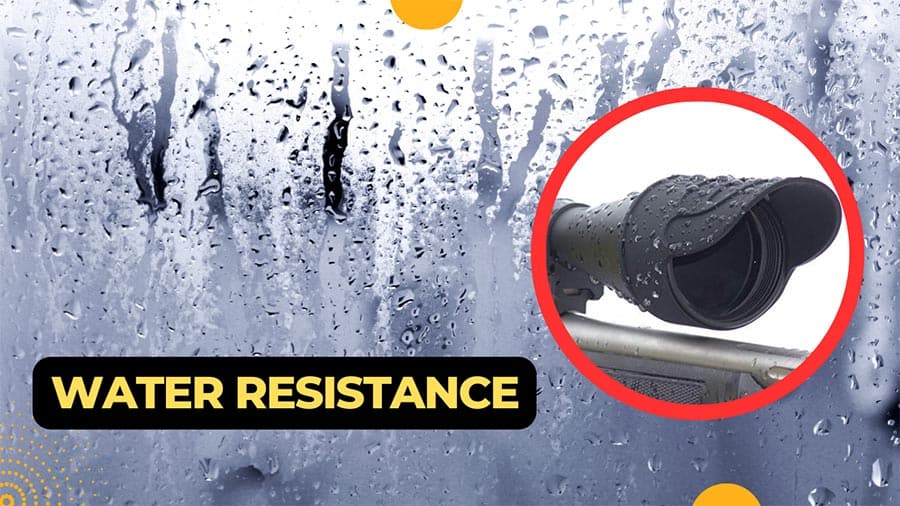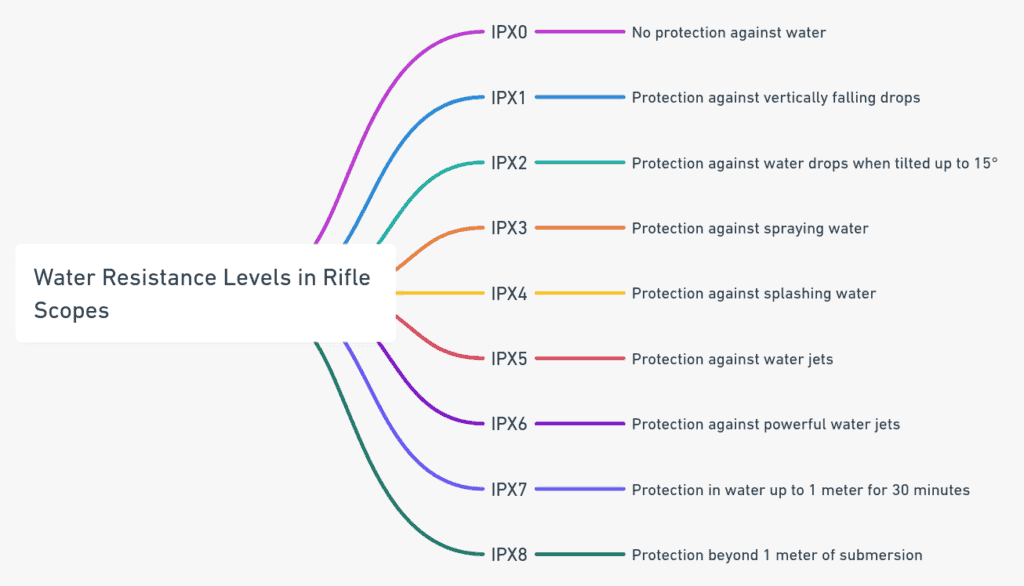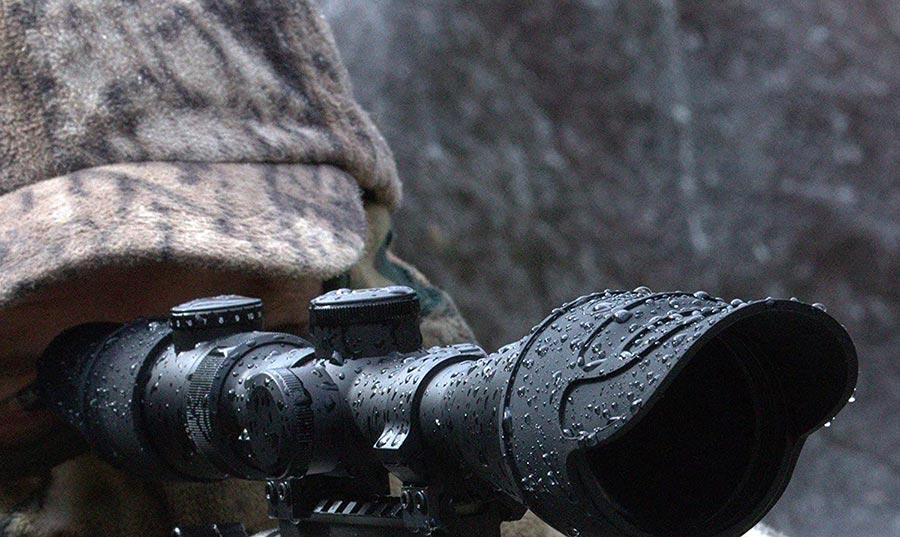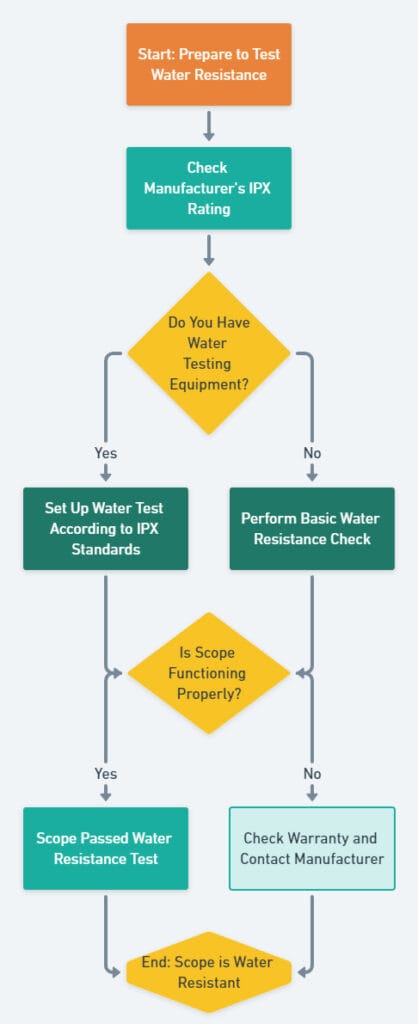A riflescope is a critical accessory for any serious shooter or hunter that wants to enhance accuracy and target acquisition. When it comes to using a riflescope in outdoor environments, encountering wet or damp conditions is inevitable. Whether it’s rain, fog, or high humidity, water can pose a significant risk to the performance and durability of a scope. That’s where the importance of water resistance comes into play.
A water resistant rifle scope is designed to withstand exposure to moisture and provide reliable performance even in adverse weather conditions. But what factors should one consider when choosing a water resistant riflescope? In this article, we will delve into the key factors to consider in selecting a water resistant rifle scope. By understanding these factors, you can make an informed decision and ensure that your scope remains reliable and effective even in wet or damp conditions. Let us get started!
- What is water resistance in riflescopes?
- Importance of water resistance in rifle scopes
- Rifle scope water resistance: what to look for
- Water Resistance in Different Environmental Conditions
- How can I test the water resistance of my scope?
- Frequently Asked Questions
- Can a water-resistant scope be submerged underwater?
- Are all rifle scopes waterproof?
- Is there a difference between water resistance and fogproofing?
- How often should I clean and maintain the water resistance of my scope?
- What are the signs of water damage in a rifle scope?
- Can I repair the water resistance of a damaged scope?
- Are water-resistant scopes more expensive than regular scopes?
- Which brands offer the best water-resistant rifle scopes?
What is water resistance in riflescopes?
Water resistance is the ability of a scope to withstand exposure to moisture, such as rain, fog, or high humidity, without compromising its performance or durability. A water resistant scope is designed to prevent water from seeping into the internal components of the scope, protecting it from moisture-related damage, such as fogging, corrosion, or condensation on lenses, which can impair visibility and accuracy. A water resistant optic may have features such as O-ring seals, nitrogen purging, and specialized lens coatings to create a barrier against water intrusion.

The level of water resistance can vary among different scope models, with some offering basic protection against light rain while others are designed to withstand more extreme conditions, such as being submerged in water or used in heavy rainfall. Water resistance is an important factor to consider when choosing a scope, especially for outdoor shooting or hunting activities where exposure to moisture is likely to occur.

IPX ratings and what they mean for the user
Importance of water resistance in rifle scopes
The importance of water resistance in scopes cannot be overstated. Here are some key reasons why water resistance is crucial in an optic:
Optical Performance
Water can cause lenses to fog up or accumulate condensation, which can significantly degrade the clarity and visibility of the scope, leading to reduced accuracy and compromised shooting performance. A water resistant scope with appropriate lens coatings and fog-proofing measures can help ensure that the optics remain clear and provide a crisp sight picture, even in wet or humid conditions.
Durability and Reliability
Exposure to moisture can damage the internal components of a scope, leading to corrosion, rust, and potential malfunction. A water resistant optic with proper seals and purging can help prevent water intrusion and protect the scope from moisture-related damage, ensuring its durable and reliable performance in adverse weather conditions.
Weather Resistance
Outdoor shooting or hunting activities often take place in varying weather conditions, including rain, fog, or high humidity. A water resistant sight is designed to withstand such conditions, allowing the shooter to maintain a clear sight picture and accurate aiming even in wet or damp environments.
Longevity and Investment Protection
Riflescopes are a major investment for shooters, and protecting that investment is important. Water resistance can prolong the lifespan of your scope by preventing moisture-related damage, such as fogging or internal component failure, which can result in costly repairs or replacements.
Enhanced Versatility
A water resistant sight can provide greater versatility in various shooting scenarios, including hunting, tactical operations, or recreational shooting, where there is a high chance of exposure to moisture. Having a water resistant optic allows the shooter to confidently use the scope in a wider range of environments and weather conditions, without worrying about damage or performance degradation due to water exposure.
Rifle scope water resistance: what to look for
Optical Performance
The optical performance of a scope is a critical factor to consider, and it becomes even more crucial in wet or damp conditions where visibility can be compromised due to fog, condensation, or water droplets on the lenses. A water resistant scope should have features that ensure good image quality, even in adverse weather conditions. Here are some key considerations for optical performance:
Lens Coatings
High-quality lens coating is essential for a scope’s optical performance, and it plays a significant role in preventing fogging, reducing glare, and enhancing light transmission. Look for a scope with multiple layers of anti-reflective coatings on all air-to-glass surfaces, such as fully multi-coated (FMC) or multi-coated (MC) lenses, which can help maintain clear visibility and minimize light loss, even in wet or foggy conditions.
Fog proof Measures
Fogging of lenses can occur when there are rapid temperature changes or exposure to high humidity. To maintain the optical performance of your scope, you must have fog proof measures in place. Nitrogen or argon gas is used to replace the air inside the scope, preventing internal fogging and ensuring better image quality, even in extreme temperature or humidity changes.
Lens Diameter and Magnification
The diameter of the objective lens and the magnification range of the scope can also impact its optical performance in wet conditions. A larger objective lens diameter can allow more light transmission through the scope and increase visibility in low light or foggy conditions. Similarly, higher magnification can make it easier to see targets clearly, even in adverse weather conditions. Although, lens clarity becomes more important in high-magnification settings. However, it’s important to balance lens diameter, magnification, and other factors that can determine the optical clarity of a scope in wet conditions.
Reticle Visibility
The visibility of the reticle, or the aiming point, is crucial for accurate target acquisition. In wet or damp conditions, the reticle may become blurred or obscured by water droplets or fog. Look out for a scope with a high contrast reticle or one designed to remain clear and visible in adverse weather conditions.
Lens Cleaning and Maintenance
Proper lens cleaning and maintenance are essential for maintaining optical performance in a scope. Get a scope with user-friendly lens cleaning procedures, such as easy-to-remove lens caps, anti-smudge coatings, or lens cleaning kits, to ensure the lenses can be easily cleaned and maintained, even in wet or damp conditions.
Durability and Construction
The durability and construction of an optic are important because they determine the scope’s ability to withstand exposure to moisture, protect internal components from corrosion, and ensure reliable performance in adverse weather conditions. Here are some key considerations for durability and construction:
Waterproofing
A good rifle scope should have effective waterproofing measures in place to prevent water intrusion. This may include O-ring seals or gaskets at critical points, such as the lens housing, turret caps, or eyepiece, to create a barrier against moisture. When searching for a scope, look for those rated with an IPX waterproofing standard, which indicates the level of protection against water, with higher ratings providing better waterproofing performance.
Shock Resistance
Every scope needs to be able to withstand the recoil and vibrations generated by the firearm when it is fired. This feature is not exempted from a water resistant scope. The scope you are choosing must have been tested and rated for shock resistance, ensuring that it can withstand the repeated impacts without losing zero or damaging internal components.
Corrosion Resistance
Exposure to moisture can lead to corrosion, rust, and damage to both internal and external components of a scope. Ensure the scope is constructed with materials that are resistant to corrosion, such as aluminum, stainless steel, or other high-quality materials, to ensure long-term durability and reliable performance, even in wet environments.
Construction Quality
The overall construction quality of a rifle scope is also needed for its durability. Look for scopes that are built with precision engineering, robust construction, and high-quality materials to ensure that they can withstand the rigors of outdoor use, including exposure to moisture, impacts, and environmental conditions.
Coating Protection
In addition to waterproofing measures, scopes may also have additional coatings or protective treatments on the exterior surfaces to enhance their durability. Check for scopes with scratch-resistant, abrasion-resistant, or impact-resistant coatings on the lens surface or external components to protect against damage from moisture, debris, or impacts.
Testing and Certification
Reliable scopes should undergo rigorous testing and be certified by independent organizations to ensure their durability and performance in adverse weather conditions. Before choosing a scope, ensure that it has been tested for water resistance, shock resistance, and corrosion resistance and is certified by reputable organizations to ensure its durability and reliability in wet environments.
Weather Resistance
Weather resistance is a crucial factor in a rifle scope. It determines the scope’s ability to perform reliably in various weather conditions, such as rain, snow, fog, humidity, and extreme temperature changes. Here are some key considerations for weather resistance:
Rainproof Performance

A water resistant scope should be able to withstand exposure to rain without allowing water to penetrate the internal components or affect the optical performance. Look for scopes with effective waterproofing measures that can withstand heavy rain or prolonged exposure to moisture without compromising performance.
Fogproof Performance
Fogging of the internal lenses can occur when there is a rapid change in temperature or humidity, which can affect the clarity and visibility through the scope. Ensure your scope is purged with dry gas, such as nitrogen or argon, during manufacturing to prevent internal fogging. Additionally, scopes with lens coatings that resist fogging, such as anti-fog or hydrophobic coatings, can further enhance their fog proof performance.
Snow and Ice Resistance
If you plan to use the scope in snowy or icy conditions, it’s important to consider its resistance to snow and ice buildup. Scopes with lens coatings that repel snow, ice, or water can help maintain clear visibility.
Temperature Resistance
Riflescopes can be exposed to extreme temperature changes during outdoor use, such as during early morning or late evening hunts or in harsh environments. That is why you’ll need a scope that can withstand a wide temperature range without failing. Scopes with materials that are resistant to thermal expansion or contraction and effective sealing and purging methods can help ensure reliable performance in varying temperatures.
Ease of Use
Here are some key aspects to consider in terms of ease of use for a water-resistant scope:
Ergonomics
The scope should be designed with user-friendly ergonomics, allowing for easy and comfortable handling, adjustments, and operation. Ensure your scope has intuitive controls, such as easily accessible turrets or knobs for windage and elevation adjustment, a smooth and easy-to-operate zoom or magnification ring, and a quick and simple reticle adjustment system. Ergonomic features, such as a non-slip grip or textured surfaces, can also enhance the ease of use, especially in wet or slippery conditions.
Quick Target Acquisition
A water resistant scope should allow for quick and easy target acquisition, especially in fast-paced shooting situations. Check if the scope you’re choosing has a wide field of view, a clear and bright sight picture, and a reticle that is easy to align with the target. Features such as illuminated reticles, daylight visible markings, or high-contrast reticle designs can also aid in quick target acquisition, even in adverse weather or low light conditions.
Eye Relief and Eyebox
The eye relief and eye box refer to the distance between the ocular lens and the shooter’s eye and the area where the shooter can obtain a full sight picture. A water resistant scope should have a comfortable eye relief and a forgiving eyebox to allow for quick target acquisition and a comfortable shooting experience, even in challenging shooting positions or when wearing eyeglasses.
User-Friendly Features
Consider additional user-friendly features that can enhance the ease of use of the rifle scope. This may include features such as a zero-reset or zero-stop function for easy zeroing and re-zeroing, a parallax adjustment for improved accuracy at different distances, a fast focus eyepiece for quick reticle focus adjustments, or a flip-up lens cover for protection against dirt, debris, or moisture. Such features can add convenience and ease of use to the scope, making it more user-friendly in the field.
Brand Reputation and Price
When considering factors for a water-resistant scope, brand reputation and price are important aspects to take into account. Here’s a closer look at these two factors:
Brand Reputation
The reputation of the brand that manufactures the rifle scope is crucial in determining the overall quality and reliability of the product. Established brands with a long history of producing high-quality optics and firearms accessories are often more reliable and trustworthy compared to lesser-known or generic brands. A reputable brand is likely to have a proven track record of delivering reliable and durable products, including water resistant scopes. Research the brand’s history, customer reviews, and feedback to assess their reputation in terms of product performance, durability, customer service, and warranty policies.
Price
The price of a riflescope is also an important consideration. Riflescopes come in a wide range of price points, and it’s essential to balance your budget with your requirements and expectations for the rifle scope’s performance and durability. Keep in mind that higher-priced riflescopes may offer advanced features, better optical performance, and increased durability, but they may not always be necessary for everyone’s shooting needs. On the other hand, cheaper options may sacrifice certain features to keep the cost low. It’s important to determine your budget and prioritize the features that are essential to your shooting requirements while considering the long-term value and durability of the scope.
Application and Intended Use
The intended use of a scope is a crucial factor to consider when selecting the right scope for your needs. Different shooting activities and environments require different features and specifications in a scope. Here are some key points to consider:
Shooting Activity
The type of shooting activity you engage in, whether hunting, target shooting, or tactical shooting, will influence the specifications you need in a scope. For example, if you primarily use your rifle for hunting in rugged and wet environments, you will need a scope that can withstand harsh weather conditions, including rain, humidity, and temperature fluctuations. On the other hand, if you use your rifle for target shooting or competition shooting in controlled environments, the water resistance requirements may not be necessary.
Environmental Conditions
Consider the environmental conditions in which you plan to use the scope. If you frequently shoot in rainy or humid conditions, a sight with higher water resistance ratings, such as IPX-7 or IPX-8, may be necessary to ensure reliable performance. Additionally, if you often shoot in dusty or sandy environments, a scope with good dust resistance and durable construction may be required to prevent damage to the optics.
Magnification Setting
The magnification setting in the scope should align with your intended use. For long range shooting, a higher magnification scope may be necessary, while a lower magnification scope may suffice for shorter range shooting or hunting in dense woods. Consider the typical shooting distances and targets you engage with, and choose a magnification range that meets your specific needs.
Scope Reticle Type
The type of reticle or crosshair in the scope is also important, as it can impact your shooting accuracy and ease of use. Different scope reticle types, such as duplex, mil-dot, BDC, or illuminated reticles, offer different functionalities and are better suited for specific shooting applications. Consider the type of shooting you do and choose a reticle that complements your shooting style and preferences.
Mounting Compatibility
Consider the compatibility of the scope with your firearm’s mounting system. Different scopes may require different types of mounts, such as Picatinny or Weaver mounts, and it’s important to ensure that the scope you choose is compatible with your firearm’s mounting system. This will ensure a secure and stable fit, which is crucial for accurate shooting.
Maintenance and Care
Proper maintenance is needed for a water-resistant scope’s longevity and optimal performance. Here are some key points to consider:
Cleaning
Regularly clean the lenses, body, and other parts according to the manufacturer’s instructions. Use a lens cleaning solution and a soft cloth to clean the lenses, and use a soft brush or cloth to clean the body and other parts. Avoid using abrasive materials or harsh chemicals that can damage the optics or the scope’s body.
Waterproof Checks
Periodically check the seals and O-rings of the scope to ensure that they are intact and functioning properly. If you notice any signs of wear, damage, or deterioration, it’s important to replace them promptly to maintain the water resistance capabilities of the scope. Always ensure that the lens caps, turret caps, and other protective covers are properly secured to prevent water or debris from entering the scope.
Storage
Store the scope in a dry and cool environment when not in use. Avoid storing it in extreme temperatures or high humidity conditions, as this can affect the performance and longevity of the scope. Consider using a protective case or cover to further safeguard the scope from dust, moisture, and other potential hazards during storage or transportation.
Handling
Handle the riflescope with care to prevent accidental damage or impacts. Avoid dropping or banging the scope, and always follow safe handling practices when attaching or detaching it from your firearm. Properly mount and secure the scope to prevent any movements or shifts during shooting that can affect its performance.
Follow the Manufacturer’s Recommendations
Always follow the manufacturer’s recommendations and guidelines for maintenance and care. Different scopes may have specific requirements or limitations, and it’s important to adhere to them to ensure the best performance and longevity of the scope. Consult the user manual or contact the manufacturer directly if you have questions or concerns about maintaining your specific scope.
Water Resistance in Different Environmental Conditions
Rain
Imagine you’re out in the field with your rifle, and it starts drizzling. In this situation, a water-resistant riflescope will come in handy. These scopes are designed to handle light rain without any issues. They have special seals, like O-ring seals, that keep water from getting inside the scope. So, even if a few raindrops fall on the scope, they won’t cause any damage. You can continue using your rifle and aiming accurately without worrying about the rain affecting your scope.
Now, let’s say the drizzle turns into a heavy downpour. Water-resistant scopes are built to handle these situations too, but every scope has its limitations. While they can withstand heavy rain to a certain extent, it’s important to be cautious. It’s a good practice to use lens covers or keep the scope protected when not in use to minimize water contact. However, in most cases, a water-resistant scope will still perform well in heavy rain, allowing you to maintain clear and precise vision.
Humidity
If you’re on a hunting trip in a tropical rainforest where the humidity is high, a water-resistant riflescope will prove beneficial. These scopes are designed to handle high humidity by incorporating special features. One of these features is nitrogen purging, which involves filling the scope with dry nitrogen gas. This process helps prevent moisture from entering the scope and causing internal fogging. With a water-resistant riflescope, you can have peace of mind knowing that the high humidity won’t hinder your vision or damage the internal components.
Let’s consider a situation where you move from a highly humid environment to an air-conditioned room or vice versa. Such sudden changes in humidity levels can cause condensation to form on the lens or glasses of any material. However, water-resistant scopes are designed to minimize this risk. The effective sealing and nitrogen purging mentioned earlier plays a crucial role in preventing condensation. To further reduce the chances of condensation, it’s recommended to allow the scope to acclimate gradually to the new environment. By doing so, you can maintain clear optics and avoid temporary fogging or blurred vision caused by condensation.
Submersion
Rifle scopes are not typically designed to survive complete submersion underwater unless they are specifically labeled as submersible. While most water-resistant scopes can withstand damp conditions and light rain, they are not built to handle prolonged submersion. It’s important to note that the specific depth to which a riflescope can survive underwater depends on its design and intended use.
Scopes labeled as submersible undergo more rigorous testing and have additional seals and reinforced construction to ensure their ability to withstand immersion. These scopes are specifically designed to handle underwater environments and can typically survive submersion up to a certain depth, such as 10 meters (30 feet) or more. They are sealed tightly to prevent water from entering and damaging the internal components of the scope.
When a riflescope is fully submerged, the water pressure can exert force on the scope’s seals and housing. Scopes that are not designed for submersion may experience water ingress, resulting in damage to the optics and other internal components. Therefore, it’s crucial to check the manufacturer’s specifications and ensure that the scope is explicitly rated as submersible if you anticipate using it in underwater environments.
If you accidentally drop a non-waterproof or non-submersible riflescope into the water, it’s important to retrieve it as quickly as possible. Once retrieved, you should take immediate steps to dry the scope thoroughly. Disassemble the scope if possible and allow all the components to air dry. Use absorbent materials like cloth or paper towels to remove any visible water droplets. It’s important to avoid using heat sources like hairdryers or direct sunlight, as excessive heat can damage the optics or other delicate parts.
Cold Weather
Rifle scopes are designed to withstand a wide range of temperatures, including cold and icy conditions. However, it’s important to note that extreme cold can still have some impact on the performance of a riflescope, and certain precautions should be taken to ensure its survival and optimal functionality. Water-resistant rifle scopes are built with seals and nitrogen purging to prevent moisture ingress and fogging, even in cold weather. These features help maintain clear optics and prevent internal components from being affected by moisture. However, extreme cold temperatures can still pose some challenges.
In very cold weather, moving parts of the riflescope, such as turrets or adjustments, can become stiff or freeze if not properly lubricated. It’s important to ensure that the scope is lubricated with appropriate oils or lubricants that are designed to withstand cold temperatures. Also, extreme cold can cause the lubricants used in the scope to thicken or solidify, affecting the overall functionality. If you anticipate using your riflescope in extremely cold conditions, it’s advisable to choose lubricants that are specifically designed for low-temperature performance.
How can I test the water resistance of my scope?
Testing the water resistance of a scope is not recommended as it can potentially damage the scope. Manufacturers conduct specific tests and provide water resistance ratings based on their internal testing procedures. It is best to rely on the manufacturer’s stated water resistance capabilities and guidelines for your particular rifle scope model. However, if you still want to take the risk, you can follow this step.

test the water resistance of my scope
Prepare a controlled testing environment
Find a basin or container large enough to accommodate the scope. Fill it with water to a level that matches or exceeds the depth limit specified by the manufacturer.
Inspect the scope
Before testing, visually inspect the scope for any visible damage or signs of wear. Ensure that all lens caps, covers, and adjustments are properly closed and secured.
Submerge the scope
Gently lower the scope into the water, fully immersing it according to the specified depth limit. Hold it steady for a few seconds to simulate the conditions it may encounter in real-world scenarios.
Check for water ingress
After removing the scope from the water, carefully inspect it for any signs of water ingress. Look for water droplets or moisture on the external surfaces, fogging or condensation on the lenses, or any other indications of water penetration.
Dry and assess the scope
Wipe the scope dry using a soft cloth and allow it to air dry for a sufficient period. Once dry, evaluate its functionality, clarity of optics, and any potential damage caused by water intrusion.
Compare the results
Compare the test results with the manufacturer’s specified water resistance rating. If the scope shows no signs of water ingress and remains fully functional, it indicates that it has passed the water resistance test to the specified depth limit.
Frequently Asked Questions
Can a water-resistant scope be submerged underwater?
Yes, these kinds of scopes can survive when submerged underwater.
Are all rifle scopes waterproof?
No, not all rifle scopes are waterproof. Rifle scopes can vary in their water resistance capabilities. Some scopes may have basic water-resistant features to protect against rain and humidity, while others may be specifically designed as waterproof or submersible scopes. It’s important to check the manufacturer’s specifications to determine the water resistance level of a particular scope.
Is there a difference between water resistance and fogproofing?
Yes, there is a difference between water resistance and fogproofing. Water resistance refers to the scope’s ability to withstand water and moisture, typically through the use of seals and proper construction. Fogproofing, on the other hand, relates to preventing internal fogging caused by temperature changes and moisture. Fogproof scopes are often nitrogen or argon purged, which helps eliminate internal fogging. While many water-resistant scopes also have fogproofing features, the terms refer to different aspects of a scope’s performance.
How often should I clean and maintain the water resistance of my scope?
Cleaning and maintenance of a water-resistant scope should be done regularly to ensure optimal performance. It is recommended to follow the manufacturer’s guidelines for cleaning and maintenance, which may include using a soft brush or cloth to remove dirt and debris, avoiding harsh chemicals, and storing the scope in a dry and protected environment. By keeping your scope clean and well-maintained, you can help preserve its water resistance capabilities.
What are the signs of water damage in a rifle scope?
Signs of water damage in a rifle scope may include fogging or condensation on the internal or external lenses, water droplets or spots inside the scope, impaired visibility or distortion in the sight picture, and malfunctioning controls or adjustments.
Can I repair the water resistance of a damaged scope?
Repairing the water resistance of a damaged scope may not be feasible or recommended. Once a scope’s water resistance is compromised, it can be challenging to restore it to its original level of protection. It is advisable to contact the manufacturer on whether a repair is possible or if a replacement is necessary.
Are water-resistant scopes more expensive than regular scopes?
Water-resistant scopes can vary in price depending on their features, brand, and overall quality. While some water-resistant scopes may be priced higher due to their advanced construction and added protection against moisture, it is not always the case that they are more expensive. The price of a scope is influenced by various factors, including brand reputation, optical quality, magnification range, and other features.
Which brands offer the best water-resistant rifle scopes?
Several reputable brands offer high-quality water-resistant rifle scopes. The best brand for water-resistant scopes may vary depending on personal preferences and specific requirements. Some well-regarded brands known for their water-resistant scopes include Leupold, Vortex, Nikon, Swarovski, Zeiss, and Bushnell. It is essential to research and compares different models within these brands, considering factors such as performance, durability, customer reviews, and warranty coverage, to determine the best scope for your needs.

Mike Hardesty is a published freelance gun writer. He also possesses specialized expertise in rifle scopes With dozens of articles and reviews published in Pew Pew Tactical, Snipercountry.com, and TTAG (The Truth About Guns), Mike is considered a firearms expert. His special area of expertise is handguns.
Mike is a long-time shooter. He has been punching paper targets, taking deer and other game and shooting at competitions since about 1975. Other related pursuits include reloading and bullet casting. He currently reloads for over 10 calibers, both handgun and rifle. His reloads, particularly for 9mm, were in great demand during the height of the ammo shortage among family and friends. He donated hundreds of rounds to informal shooting sessions. He was quoted as saying “I do not sell my reloads but I sure will help my guys shoot ’em for free!”. He has a few cherished firearms that he has inherited or otherwise procured — those are his favorites.
He earned B.S. and M.S. degrees from Indiana State University in 1974-1975.
He’s a firearm experts and is the founder of mhardesty.com.
